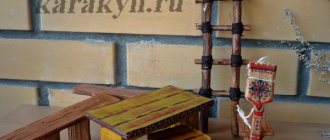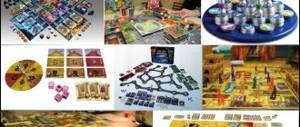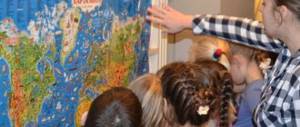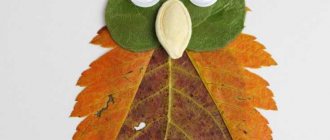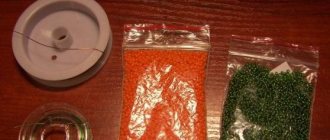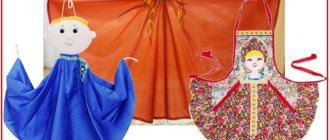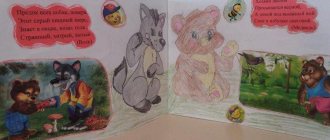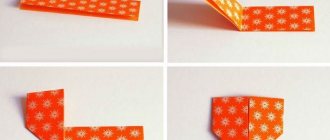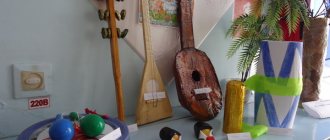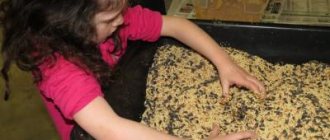Important aspects of compiling a lapbook “Wild Animals”
The compilers of the manual can be either teachers, if the lapbook is intended for children of younger groups, or parents, for example, if creating a lapbook is a project task in kindergarten, or mom and dad want to systematize the materials they use with their child. In any case, the manual will work much more effectively if children are involved in its creation . Toddlers and children of middle preschool age can arrange and glue pictures, and students in older groups can even participate in compiling a selection of materials.
Classes with a laptop teach children to independently find solutions and draw conclusions
Choosing a theme
The topic “Wild Animals” is very broad, so it is more practical to narrow down the topics covered, for example:
- "Wild Animals of Russia";
- “Wild animals of our native land”;
- “Wild animals of central Russia”;
- "Exotic animals";
- "Groups of animals by type of nutrition."
Benefit form
For the “Wild Animals” lapbook, you can use the following forms of organizing materials:
- a mobile folder with 3-4 opening spreads or two doors - traditionally, materials for younger groups are organized in this way, since the manual for this age is dominated by pictures, and the shape of the slide allows you to view all the illustrations at once;
- a folder cut out according to the silhouette of an animal, for example, a bear;
- accordion folder - this is usually how materials for older preschoolers are designed, since younger ones can get confused with opening and closing pages.
Which method and format of organizing a laptop to choose?
Pockets are the most convenient way to organize information in a manual. This option for storing materials is especially in demand for children of primary and secondary preschool age. But for older preschoolers, you can also use envelopes that close with a “tab” on the top flap, which fits into the hole on the envelope.
Blocks of materials can be stored:
- in envelopes with curly silhouettes (for example, cones or baskets for organizing materials related to food for wintering animals);
Even if the manual assumes the presence of shaped envelopes, the basis should still be ordinary ones, since they are the most convenient and practical
- in folding books for the design of riddles, poems or proverbs, sayings, as well as under pictures with texts for practicing the correct names of male, female and baby animals;
- in doors, for example, in a laptop for kids, this is how you can design a poem, which is the basis of the information block of the entire manual;
- in windows - usually thematic pictures depicting animals, their habitats and cubs are placed in this way;
- on spinning reels, where the arrows are positioned so that one points to the beast and the other to the “child”.
As when creating manuals on other topics, all materials - texts, pictures - are placed on cards.
The format for submitting information can be in the form:
- puzzles;
- illustrations (without text for children to write descriptions or for designing an information block);
- games;
- poems;
- riddles (for the first younger group this block is not needed, but in the second group riddles are given with answers in rhyme);
- proverbs, sayings (this block is included only in manuals for older preschoolers);
- coloring books (for kids, drawings should have large elements);
- discs with audio and video materials on the topic (recordings of sounds made by animals, educational cartoons, presentations).
DIY layouts for kindergarten. Animal world
Do-it-yourself models of the animal world for preschool educational institutions
Relevance: During the period of preschool childhood, the formation of the human personality and the formation of the beginnings of ecological culture take place. Therefore, it is very important to develop children’s interest in living nature, cultivate a love for it, and teach them to take care of the world around them. Problem : children’s insufficient understanding of animals in hot and cold countries (features of appearance, habitat, food). Goal : To expand children's knowledge about animals of hot and cold countries. Introducing children to the characteristic features of animals in hot and cold countries. Objectives: 1. Development of the need to acquire new knowledge about animals; 2. Formation of skills to learn new information; 3. Determine the importance of animals of hot and cold countries for the ecosystem. 4. Name and describe the characteristic features of animals. 5. Learn to find differences and similarities among the animal world of hot and cold countries. 6. Develop the ability to listen to each other, ask questions on the topic. 7. Foster a caring attitude towards nature. Expected result: 1. will know: the names of animals in Africa, the Arctic and Antarctic; features of their appearance; habitat, nutrition, benefits in nature. 2. will be able to: read poems about animals, make riddles; identify animals by appearance; collect cut-out pictures, color pictures of animals; draw and sculpt animals. 3. will cultivate: an attentive, caring and caring attitude towards animals. We rarely think that another life is in full swing around us. Fluffy, feathered, growling, meowing creatures live their amazing lives. Scientists have discovered so many interesting facts about animals! Reading stories, fairy tales, looking at illustrations, the guys began to ask a lot of questions, what is the animal world? This is an elephant - it is big, and the tallest is a giraffe, a very beautiful bird, a parrot, can learn up to a hundred words. Therefore, I decided to make models with different types of animals and their habitats. So that the child can not only distinguish a panther from a domestic cat, but also make up interesting stories about the unusual capabilities of animals. Children can take the models and use them in free play activities. The kids really like to find new animals, get to know them, learn interesting facts, talk about them, and most importantly, come up with different stories. The kids also enjoy watching the underwater world, finding gold coins and more.
We recommend watching:
Fire safety layout in kindergarten Do-it-yourself layouts for kindergarten Do-it-yourself farm layout for kindergarten Do-it-yourself layout for kindergarten. birdhouse
Similar articles:
DIY layout for kindergarten on the theme Autumn
Materials for the lapbook “Wild Animals”
The material bank can be replenished annually.
Information part
This block includes:
- general information about wild animals, including information about lifestyle, nutrition, etc.;
- information about unusual animals - these materials can even be included in a lapbook for kids;
- interesting facts about animals - such materials are used for teaching aids, starting from the middle group;
- materials about forest animals;
- information about exotic animals, including those that can be kept at home - the materials will be especially interesting for preschoolers who dream of having a pet;
- rules of behavior when meeting a wild animal - this information should be included in lapbooks starting from early preschool age.
Poems on the topic “Wild Animals”
For kids, rhymes should not be too long:
- He walks through rubble and ravines with a master's step. The bear loves sweet honey and picks raspberries from the branches.
- The noise of the forest rolled through - The scythe fell silent under the bush. He pressed his long ears back and followed the echo for a long time.
- The little fox knows: All her beauty is in her fur coat. There is no red fur coat in the forest, There is no more cunning beast in the forest.
- Day and night he prowls the forest, Day and night he searches for prey. The wolf walks and wanders silently, with gray ears erect.
For older children there may be more lines, and the range of fauna representatives described is wider:
- What is this strange little deer? He decided that he was a donkey. He repeated all day: “I’m a donkey, I’m not a deer!” And then my mother said: “How stubborn you are! Almost drove me crazy. Maybe you’re really an ass?”
- Red squirrel with a red tail Found a little red squirrel under a bush. She salted the little saffron milk cap. I put it in a large jar. The squirrel is no longer afraid of the cold: she has food for the whole winter.
- A smart animal, the boar loves to tear up the earth. He finds underground, Something that can be eaten. Boars are strong and agile, they run quickly in the forests. They are not afraid of wintering either. The fur on boars is thick.
Riddle block
For children of the second younger group, the selection may be as follows:
- I am an orange animal, The fur coat is warm, like a hot water bottle, The tail is soft, like fluff, I am diligent... (squirrel);
- It is thorny, but not a Christmas tree, In needles, but not a pine tree. It can curl up into a ball. Of course, this is... (hedgehog);
- Branches crunch in the forest, here and there. Looking for acorns... (boar).
For children in the middle group, riddles should be about animals that they know well:
- I am gray, I live in the forest, I know a red fox. I sing a sad song, howl loudly at the moon. (Wolf);
- There are workers in the river, not joiners, not carpenters. And they will build a dam, At least paint a picture. (Beavers);
- Jumper-coward: Short tail, eyes with a braid, ears along the back, clothes in two colors - for winter, for summer. (Hare).
You can include riddles about exotic animals in a lapbook for older preschoolers:
- It’s easy for us to recognize him, It’s easy to recognize him: He’s tall and sees far. (Giraffe);
- The horses put on nautical vests. (Zebra);
- He has a lot of strength, he is almost as tall as a house. He has a huge nose, As if his nose has been growing for a thousand years. (Elephant).
Games for the lapbook “Wild Animals”
The manual should include all types of games: didactic, active, theatrical and finger games.
Table: examples of games for the “Wild Animals” lapbook
| Name of the game | Rules | The target audience |
| Didactic | ||
| "Whose Shadow" | Children connect the shadow with the animal. | Junior, middle |
| “Recognize the beast by description” | The teacher describes the animal, the children guess what it is about:
| Middle, senior groups |
| "The Fourth Wheel" | Children look at the picture and choose the “extra” animal (usually the selection principle is based on what kind of animal it is: domestic or wild). Older preschoolers can complete the task at speed. | Middle, senior |
| Puzzles | The guys assemble an image from fragments:
| |
| Movable | ||
| “Animals gathered at the forest edge” |
| Second junior group |
| "The Hunter and the Hares" |
| Middle and senior groups |
| Theatrical | ||
| Imitation Games | Children perform movements in accordance with the text:
| Junior, middle groups |
| Finger | ||
| "Squirrel" |
| Junior group |
| "Hedgehog" |
| |
Photo gallery: materials for the games “Whose Shadow”, “The Fourth Wheel” and for puzzles
The game “Whose Shadow” can be played at speed
In the game "The Fourth Wheel" there is usually one domestic animal among the wild animals.
In the game "Odd Four" the guys train their reaction speed and logic
For kids, puzzles can be made from pictures, not photographs.
Children of the middle and senior groups can put together puzzles for a while
Literary works on the topic
Texts of fiction in the form of passages for retelling or in the form of a list recommended for reading with parents are necessarily included in the lapbook. The selection includes fairy tales and stories for children of all ages.
Visibility
The basis of the entire manual is clarity. On the one hand, it provides the aesthetic appeal of the lapbook, and on the other hand, it provides materials for working with children on the topic. Moreover, thematic pictures can be in the form of individual images of animals, or they can have a more complex form, for example, when the illustration shows at once images of the animal’s home, the cub, and the diet.
Photo gallery: examples of pictures on the topic “Wild Animals”
You can invite children to look at the picture and remember the poem about this animal
Looking at the picture, the guys can name fairy tales where this animal was a character
When talking about a wolf, children emphasize that it is a predator
The description of the animal must include its lifestyle at different times of the year.
The story about the animal includes a description of its appearance
In the description of the animal, older preschoolers include a list of the areas of distribution of the animal
Cartoons
The block of visual materials also includes a CD with video materials on the topic, work with which involves discussion after viewing.
Video: educational cartoon “Animals of Africa”
Video: cartoon “Tig and Leo” for the lapbook “Animals of the Taiga”
Video: cartoon “Kangaroo Family” for the lapbook “Exotic Animals”
Video: educational cartoon “Forest Animals”
Section with puzzles and coloring pages
Pictures for children of all ages and tasks for ingenuity for pupils of the middle and senior groups are also mandatory elements of the lapbook.
Photo gallery: a selection of pictures for coloring on the theme “Wild Animals”
In this picture, children practice the precision of strokes made with a black pencil
Children can make up stories using ready-made drawings
To add texture to the squirrel's fur, you can use the fork stamp coloring technique.
In addition to coloring, you can invite the children to remember an interesting fact about the animal
To color a wolf, you can use a simple pencil, varying the pressure to create shades of color.
For kids you need to select pictures with a small amount of detail; single-color large predators are suitable
It is important that children know exactly the name of the animal they are coloring.
Photo gallery: puzzles and crosswords for the lapbook “Wild Animals”
Crossword puzzles can be based on descriptions of animals, riddles
The answers to this puzzle are compiled according to the first letters of the names of the depicted objects
Answer: fox
Options for using the manual in a group and at home
As mentioned earlier, the benefit can be used not only in kindergarten, but also at home. Moreover, at different stages of consideration of the topic: when familiarizing themselves with the material, children can describe pictures and memorize poems. In the process of practicing the material - play, color, solve puzzles.
In this case, work can be organized both individually and in a group.
When preparing a lesson, the teacher can use a lapbook at each stage of the GCD. For example, to update basic knowledge, you can use riddles, at the main stage of the lesson - games, work with pictures, texts of fiction, and at the final stage - puzzles and/or coloring books.
What is central Russia?
The territory of the European part of our country, characterized by a temperate continental climate, is usually called the central zone of Russia. Another name for it is the Central Russian region. That's what it was called during the Soviet Union. The nature of central Russia is diverse and amazing. Some animals and plants inhabiting European territory are practically no longer found in remote regions of our country.
